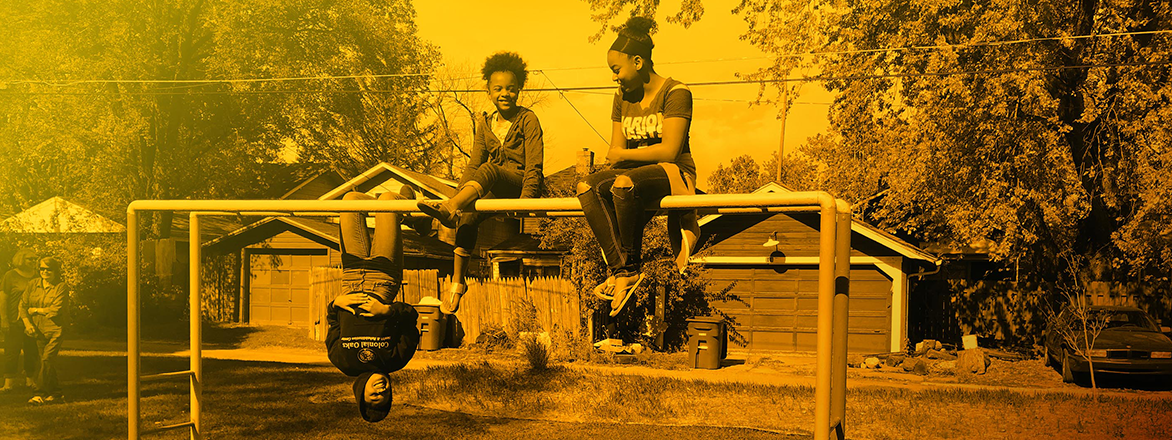Creating Safe Spaces in Communities
Creating Safe Spaces in Communities
| “The park can transform the neighborhood, not just aesthetically, but the state of mind, the state of wellbeing for people in general." |
Creating safe community spaces in partnership with community leaders is intimate partner violence prevention!
Community conditions such as equitable access to resources, housing, and connectedness to community may make it less likely that children, families, and communities will experience violence. The prevention approaches highlighted in this story address community conditions that give rise to, protect against, or counter violence in communities and reflect a multi-generational approach that has the potential to create lasting safe, stable, nurturing relationships and environments. In this story, the coalitions in Indiana, North Carolina, and Rhode Island sought to create safe spaces in the community by building parks, addressing housing stability, and strengthening community ties.
Key Lessons Learned & Highlighted Strategies
“There’s so much opportunity in prevention work to build something better instead of to find the most expedient, good-enough for some answer to urgent individual/family needs. But it is only an opportunity – there is also the opportunity to try to build toward safer communities inequitably or through harming some marginalized folks to further prevention for folks with more privilege. I think the key lessons in this report are critical to building safer community spaces equitably and justly.” – Deena Fulton, North Carolina Coalition Against Domestic Violence
Key Lesson #1: Gaining engagement and buy-in from community stakeholders requires building trust.
The coalitions also learned that in order to create safe community spaces, they needed to engage multiple groups of stakeholders.
- Community-based organizations in Indiana worked together to create a group of “core champions” from the community to foster neighborhood buy-in and engagement.
In Indiana, Hands of Hope partnered with the Garfield Neighborhood Association and city leadership (Hands of Hope Community Coalition) to implement the Garfield Neighborhood approach. One aspect of the approach included Hands of Hope Community Coalition collaborating with members of the Garfield Neighborhood Association to develop a group of “core champions.” Those “core champions” were local community members who built trust with other neighbors by demonstrating that they, too, were directly affected by the project and invested in its outcomes. This increased neighborhood engagement and helped provide an opening for other neighborhood residents to get involved in the work.
- Advocates in Rhode Island talked to neighborhood residents to learn about their challenges and then worked together with them to address them.
In Rhode Island, the Newport Community Coalition conducted “on-the-ground” work in neighborhoods and listened closely to what youth and other community members told them about the problems facing their neighborhoods. This approach was particularly important because historically, programs were implemented in the neighborhoods without the input of the community, which created a barrier to the community’s acceptance of new programming. As a result of these discussions, the Coalition engaged in restorative, anti-racism practices that led the community to view them as partners rather than service providers. In turn, the trust helped bring different neighborhoods together to address historical separation and segregation.
“Our North End History program opened the eyes of so many. We discovered and shared the stories of those marginalized and segregated, bringing them to the forefront to ensure they are no longer forgotten.” – Newport Health Equity Zone (HEZ) Strategy Specialist, Rhode Island
- The coalition in North Carolina invited a variety of partners – both individuals and organizations invested in and impacted by housing policies – into their process.
The North Carolina Coalition worked with local organizations called Continuums of Care (CoCs), community groups that make decisions about how housing policies are implemented at the community level, on their rapid rehousing approach. Because rapid rehousing spans multiple systems, the North Carolina Coalition engaged with a wide array of subject matter experts and directly engaged localities and the state in the process in order to promote IPV survivors’ agency and choice within housing systems.
Key Lesson #2: When creating stable protective environments, it helps to connect prevention approaches to broader community and systems changes.
- Advocates in Rhode Island built a relationship with a collective whose broader goals and vision aligned with theirs.
The Newport Health Equity Zone (HEZ) is a citywide collaborative seeking to address health disparities. Established through the Rhode Island Department of Health’s HEZ initiative, it shared a common goal with the Newport Community Coalition’s Youth Connectedness Collaborative of building social cohesion because it has been linked to decreases in social violence and improved health outcomes. This common goal connected the project this broader initiative that had a “really strong resident voice and principles of empowerment” and helped center it in the community as more than a stand-alone strategy.
- In Indiana, advocates changed their direction to respond to their community’s needs for neighborhood improvement.
Hands of Hope Community Coalition began their approach thinking that the responsibility and solution for creating safe spaces was encouraging more engagement from residents. Instead, they came to realize creating structural supports were needed to create the safety they envisioned. According to the City Mayor working in partnership with Hands of Hope Community Coalition, structural improvements were not just nice to view, but they could also improve the well-being of the community overall.
- Advocates in North Carolina connected their efforts to the broader goals of fostering stronger and healthier families.
The North Carolina Coalition saw rapid rehousing as a chance to address a root cause of negative outcomes for IPV survivors and their children. Connecting their approach to changes in the housing system could offer short and long-term benefits by strengthening parent-child relationships, providing stable housing, and reducing long-term health risks for children exposed to violence.
Key Lesson #3: Developing or supporting a community or system approach to creating safe spaces requires time and persistence.
- In Indiana, advocates extended their timeline to allow for the meaningful participation of community partners.
Hands of Hope Community Coalition credited much of their success to the productive working relationships created with their core champions (e.g., university students, businesses, and city officials) and the resources that came from these partnerships. However, the logistics of working with cross-sector partners and their reliance on volunteer labor and resource availability often meant that they were “at the mercy of whenever [partners are] going to be able to do” project tasks. This compelled them to make major changes to their original design plan for the park and project timeline, as well as adjustments to their evaluation approach.
- Advocates in Rhode Island slowed their pace so they could be more responsive to the community’s needs at every step of the project.
The Newport Community Coalition also put a great deal of effort into their early planning but found it necessary to exercise flexibility throughout each step of their approach because of several factors including resistance from potential community partners. While managing internal expectations about the timeframe for completing project goals represented a challenge throughout implementation and evaluation, the shift in pace was intentional so the team could avoid making assumptions and identify the true needs of the community they were serving.
- In North Carolina, advocates extended their project timelines to allow more time for learning from the community.
The North Carolina Coalition also quickly learned once implementation began that the systems and necessary relationships between partners were more complex than they had anticipated. As a result, they found it necessary to step back and build in additional time for learning. This helped them avoid making assumptions and fully understand the needs and opportunities for creating lasting system changes.
* Community connectedness refers to the nature and quality of engagement among community members, including individuals, families, neighborhoods, groups, organizations, institutions, and social networks (i.e., schools, cultural-based organizations, faith communities, social media). It involves the relationships people have with each other as well as their level of engagement with the broader community. In connected communities, members gain a sense of belonging, purpose, and mattering from the experience of both deriving value from and adding value to their community. Stronger connections increase a person’s sense of hope and self-worth, and the ability to cope adaptively in the face of adversity. As a result, community connectedness is a protective factor that enhances well-being, fosters resilience, and promotes prevention. A connected community is where people build relationships, strong social networks, and thrive.
Tools for Adaptation
- from the Indiana Coalition Against Domestic Violence
- from the Indiana Coalition Against Domestic Violence
- Video: Barnes Park Reopening (October 2017) from #SmallMoments: Barnes Park at the Indiana Coalition Against Domestic Violence
- Illustrating Our Prevention Story by the Indiana Coalition Against Domestic Violence
- from the North Carolina Coalition Against Domestic Violence – Includes literature review (pp. 17-48) and community readiness assessment (pp. 80-114)
- Community Intake Center Policy and Procedure Manual (December 2017) from the Winston-Salem/Forsyth County Continuum of Care – See Safety Planning and Domestic Violence (p. 12)
- from the Winston-Salem/Forsyth County Continuum of Care – See Domestic Violence Policy (p. 27)
- NC Balance of State Continuum of Care System Standards: Coordinated Entry from the North Carolina Coalition to End Homelessness – See Safety Planning (p. 16)
Highlighted Projects
- Indiana Coalition Against Domestic Violence’s Hands of Hope Community Coalition, a Division of Family Services Society, Inc. – Garfield Neighborhood Association
- North Carolina Coalition Against Domestic Violence – Rapid Rehousing/Continuums of Care
- Rhode Island Coalition Against Domestic Violence’s Newport Community Coalition, Women’s Resource Center – Youth Connectedness Collaborative & Newport Health Equity Zone
Related Resources from DELTA FOCUS Grantees
- Web Conference Recording & Summary – A Safe Place to Call Home: Transforming the Physical/Built Environment for Sexual and Domestic Violence Prevention (August 2017) from PreventConnect
- Peer Learning Forum: Implementing Community-Level Strategies to Prevent Sexual and Domestic Violence (October 2017) from PreventConnect
- New Hanover County: Building Community, Opportunity, & Equity through Place-Based Collaboration from Prevent Violence NC
- VAWnet TA Question – How can my agency invest in building equitable community environments that support safe relationships? (November 2017) by Lisa Fujie Parks, with Morgan Croce and Alisha Somji for the Prevention Institute





